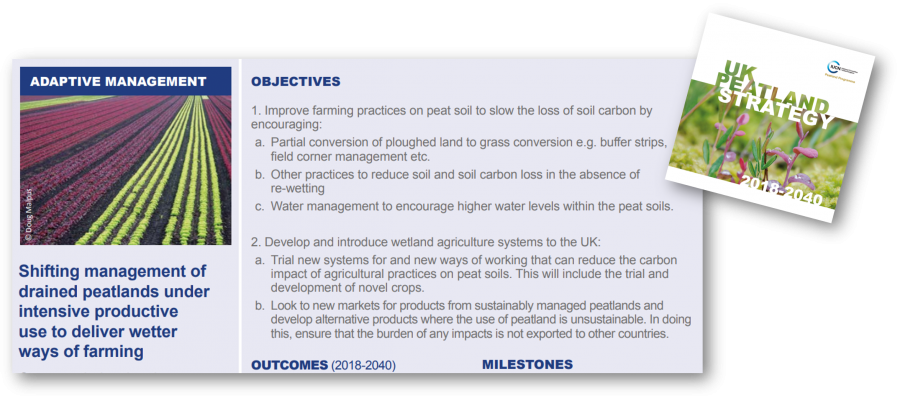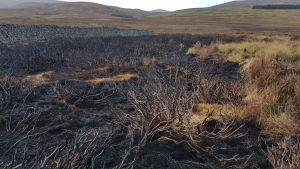With the urgent need to reduce our carbon emissions wherever possible, complimenting traditional agriculture on drained peatlands with wet farming techniques could help reduce greenhouse gases emitted from damaged peatlands.
Most of us consume products grown on peat on a daily basis. Crops such as lettuce and celery are grown directly on peat soils in East Anglia. Dairy cattle are, in places, grazed on intensively drained peatland. Garden produce is often grown in peat-based compost and palm oil can come from trees planted where Southeast Asia’s swamp forests previously stood. All are based on agricultural practices first developed in the dry lands of the Middle East’s Fertile Crescent’ about 12,000 years ago. As farming spread, humankind began an obsession with draining soils for dry-land agriculture rather than working holistically with the prevailing conditions of the land.
Extensive drainage has taken a significant toll on our peatlands. In the UK 80% of peatlands are in a damaged or deteriorating state. When naturally wet peat soils are drained, oxygen enters the soil and releases large amounts of carbon that may have been locked away for millennia, as carbon dioxide. Damaged peatlands are currently responsible for 4% of the UK’s greenhouse gas emissions, with drainage based agriculture accounting for 60% of these emissions despite covering just 15% of UK peatland area1.

Above: Adaptive management of drained peatlands to a wetter, more sustainable productive use is one of the UK Peatland Strategy goals.
Continued agricultural management of peat through drainage and tillage leads to soil degradation, subsidence and a loss of productivity. These ‘wasted’ peat soils pose a real risk to the future of UK food production, especially in areas of England such as the East Anglian Fens.
In Scotland the productive use of peatlands is predominantly extraction as oppose to agricultural. Although many peat mining sites, mainly providing peat for the horticultural industry, have the potential to be restored to peatland habitat pressures from surrounding land use and / or the cost of restoration can be prohibitive for some sites. Equally, with peat covering 20% of Scotland’s land area and 33% of Britain’s fresh vegetables grown in the Fens, the UK cannot afford to cease economic activity on all areas of peat. Adaptive management of these damaged lowland sites, shifting productive use from mining to wet agriculture (also known as Paludiculture from the latin ‘palus’ meaning swamp and ‘cultura’ for care, or cultivation), could help reduce UK greenhouse gas (GHG) emissions and diversify the future of agriculture.
Above: The video below gives a short introduction to the growing of Typha in Mecklenburg Vorpommern, Germany. It's potential as a crop is being explored by a range of organisations, including the CANAPE project. Video credit: Susanne Brahms.
Paludiculture is not nature protection: it is agriculture with clear production goals. But what paludiculture is, is a wetter way of farming on peatlands that does not degrade the peat layer and can even add to peat accumulation. Re-wetting areas of peat and stabilising water levels close to the surface help to immediately reduce the amount of carbon being emitted as greenhouse gases. There can also be direct wins for biodiversity, as cultivated crops can support species such as sundews and breeding golden plover.
As a form of land management paludiculture is in the early stages of development. Of Europe’s 28.5 million hectares of degraded peatlands, less than 1% has been re-wetted, with paludiculture covering only a fraction of this area. But it’s not an entirely new practice. For thousands of years products from wetlands such as reeds (Phragmites) have been harvested as fuel and raw materials for construction. Other wet peat crop products include food for people and livestock and medicines as well as modern uses in construction and as biomass for energy production.

Above: from left to right: Reed harvesting, Western Pommerania © Tobias Dahms; Sphagnum farming pilot site, Greifswald Mire Centre and peat company Moorkultur Ramsloh, Lower Saxony © Tobias Dahms; Wetlands Product Foundation – Aldert Typha products © Emma Goodyer
Developing a paludiculture approach in the UK will require suitable sites and crops to be identified; the technical challenges of farming on wet land to be overcome; the development of production lines and markets for novel produce; and recognition and provision through developing agri-environment schemes.
Extensive trials are already underway in the UK to look at bringing peatland products to market. Sphagnum farming is being trialled to produce raw Sphagnum or ‘white peat’ as a peat replacement to support and maintain the horticulture industry in the UK; after all, Sphagnum is really just new peat that hasn’t decomposed yet and offers many of the same properties as peat-based compost. With careful management, it would be possible to grow and harvest Sphagnum sustainably from paludiculture sites.
Paludiculture is not a panacea and cannot be sustainably applied everywhere. Just as we wouldn’t advocate turning native woodlands over to productive forestry, we wouldn’t advocate that natural bogs are converted to sustainable productive use. Wet agriculture is also not a replacement to or competitor of traditional farming but another tool in the toolkit for farmers and growers looking to diversify their business and protect their peat soils. However, with the large areas of damaged peatland we have left to restore, paludiculture does presents a useful tool in lessening the climatic and biodiversity impact of abandoned peat extraction sites while maintaining economic productivity.
For more information:
- Commission of Inquiry report on Productive Lowland Peatland
- Potential crops for paludiculture in temperate, boreal and tropical climates (2013) FAO, Abel. S.,
University of Greifswald. - Greifswald Moor Centre - Sustainable use expertise & Projects
- Wet farming, A Water Works Project - looking at ways to develop a more sustainable future for fenland resources funded by People’s Postcode Lottery Dream Fund.
- CANAPE (Creating a New Approach to Peatland Ecosystems) is a European funded Interreg North Sea Region project.
- Care-Peat Project - Restoring the carbon storage capacity of peatlands, a European funded Interreg North West Europe project.
- Geurts, J.J.M., Fritz, C. (2018) Paludiculture pilots and experiments with focus on cattail and reed in the Netherlands. CINDERELLA project Technical Report, Radboud University Nijmegen Department of Aquatic Ecology & Environmental Biology Institute for Water & Wetland Research (IWWR) DOI: 10.13140/RG.2.2.12916.24966
References
1 Evans, C., Artz, R., Moxley, J., Smyth, M-A., Taylor, E., Archer, N., Burden, A., Williamson, J., Donnelly, D., Thomson, A., Buys, G., Malcolm, H., Wilson, D., Renou-Wilson, F., Potts J. (2017). Implementation of an emission inventory for UK peatlands. Report to the Department for Business, Energy and Industrial Strategy, Centre for Ecology and Hydrology, Bangor.88pp .










